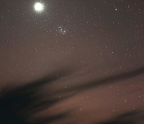The Milky Way’s Dark Constellations

THE MILKY WAY can be rather difficult to see these days, due to light pollution. Many in urban areas don’t get a good look at it at all, and it can even lose some of its lustre in rural locations. I can’t discern much of our galaxy’s dusty plane from where I live, but in 2019 I was fortunate to attend a star party under very dark skies where I was able to gaze upon the beauty of the Milky Way for the first time in quite a while.
People in ancient cultures were lucky, because they could see this wonder regularly. There wasn’t much light after dark, and their skies were brilliant with the glow of countless stars when clear of clouds on moonless nights. Shadowlike swaths of dusty interstellar gas, including patches that we today call dark nebulae (see page 58), accentuated the beauty.
Because the sky was an integral part of daily experience, it’s no surprise that many cultures employed astronomy in a number of ways. The field of archaeoastronomy studies how ancient peoples utilised their knowledge of the heavens. They often employed it calendrically for such matters as crop management and planning the dates of religious festivals. Some also engineered impressive visual effects of light and shadow at significant times of the year, such as at the solstices.
Of course, these civilisations also noted patterns in the sky. They imagined the shapes
You’re reading a preview, subscribe to read more.
Start your free 30 days





